Report Analysis: Fulcrum Therapeutics' Losmapimod for FSHD Treatment
VerifiedAdded on 2022/08/12
|7
|1286
|24
Report
AI Summary
This report analyzes a news article from Globe Newswire concerning Losmapimod, a p38α/β mitogen-activated protein kinase (MAPK) inhibitor, and its potential in treating Facioscapulohumeral Muscular Dystrophy (FSHD). The article discusses the Orphan Drug Designation (ODD) granted by the FDA and the US patent covering its use. It highlights the promising clinical trials, particularly the phase 2b ReDUX4 trial, which demonstrated muscle relaxation efficacy. The report emphasizes the role of Fulcrum Therapeutics in discovering the drug's potential to reduce DUX4 gene expression. It also notes the clinical trials, the company’s product engine, and the company's focus on improving the lives of patients with rare genetic diseases. The report also discusses the data authenticity, sample size, and relevance of the findings, particularly from an Occupational Therapist's perspective, who supports the research and the need for drug analysis before launching.
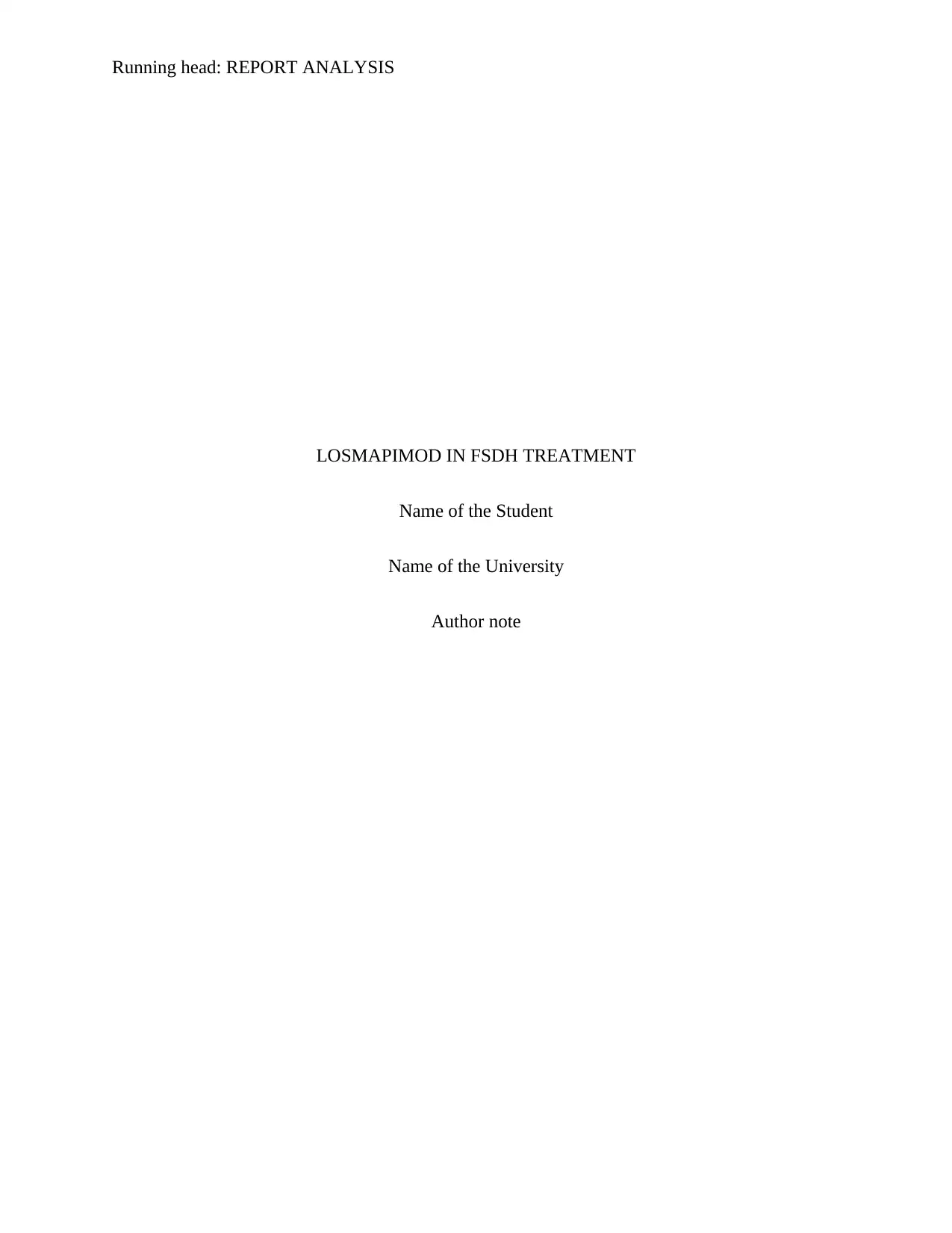
Running head: REPORT ANALYSIS
LOSMAPIMOD IN FSDH TREATMENT
Name of the Student
Name of the University
Author note
LOSMAPIMOD IN FSDH TREATMENT
Name of the Student
Name of the University
Author note
Paraphrase This Document
Need a fresh take? Get an instant paraphrase of this document with our AI Paraphraser
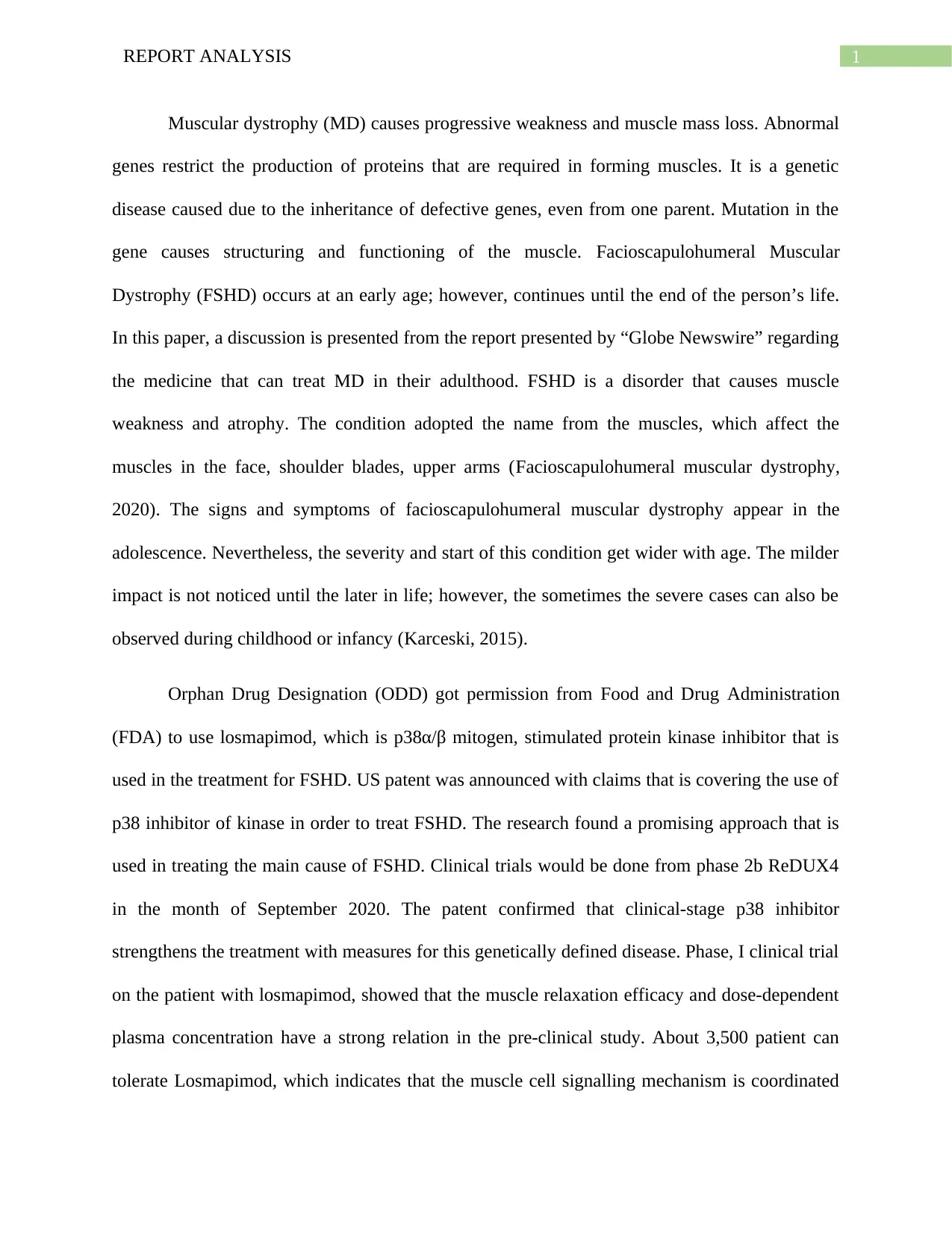
1REPORT ANALYSIS
Muscular dystrophy (MD) causes progressive weakness and muscle mass loss. Abnormal
genes restrict the production of proteins that are required in forming muscles. It is a genetic
disease caused due to the inheritance of defective genes, even from one parent. Mutation in the
gene causes structuring and functioning of the muscle. Facioscapulohumeral Muscular
Dystrophy (FSHD) occurs at an early age; however, continues until the end of the person’s life.
In this paper, a discussion is presented from the report presented by “Globe Newswire” regarding
the medicine that can treat MD in their adulthood. FSHD is a disorder that causes muscle
weakness and atrophy. The condition adopted the name from the muscles, which affect the
muscles in the face, shoulder blades, upper arms (Facioscapulohumeral muscular dystrophy,
2020). The signs and symptoms of facioscapulohumeral muscular dystrophy appear in the
adolescence. Nevertheless, the severity and start of this condition get wider with age. The milder
impact is not noticed until the later in life; however, the sometimes the severe cases can also be
observed during childhood or infancy (Karceski, 2015).
Orphan Drug Designation (ODD) got permission from Food and Drug Administration
(FDA) to use losmapimod, which is p38α/β mitogen, stimulated protein kinase inhibitor that is
used in the treatment for FSHD. US patent was announced with claims that is covering the use of
p38 inhibitor of kinase in order to treat FSHD. The research found a promising approach that is
used in treating the main cause of FSHD. Clinical trials would be done from phase 2b ReDUX4
in the month of September 2020. The patent confirmed that clinical-stage p38 inhibitor
strengthens the treatment with measures for this genetically defined disease. Phase, I clinical trial
on the patient with losmapimod, showed that the muscle relaxation efficacy and dose-dependent
plasma concentration have a strong relation in the pre-clinical study. About 3,500 patient can
tolerate Losmapimod, which indicates that the muscle cell signalling mechanism is coordinated
Muscular dystrophy (MD) causes progressive weakness and muscle mass loss. Abnormal
genes restrict the production of proteins that are required in forming muscles. It is a genetic
disease caused due to the inheritance of defective genes, even from one parent. Mutation in the
gene causes structuring and functioning of the muscle. Facioscapulohumeral Muscular
Dystrophy (FSHD) occurs at an early age; however, continues until the end of the person’s life.
In this paper, a discussion is presented from the report presented by “Globe Newswire” regarding
the medicine that can treat MD in their adulthood. FSHD is a disorder that causes muscle
weakness and atrophy. The condition adopted the name from the muscles, which affect the
muscles in the face, shoulder blades, upper arms (Facioscapulohumeral muscular dystrophy,
2020). The signs and symptoms of facioscapulohumeral muscular dystrophy appear in the
adolescence. Nevertheless, the severity and start of this condition get wider with age. The milder
impact is not noticed until the later in life; however, the sometimes the severe cases can also be
observed during childhood or infancy (Karceski, 2015).
Orphan Drug Designation (ODD) got permission from Food and Drug Administration
(FDA) to use losmapimod, which is p38α/β mitogen, stimulated protein kinase inhibitor that is
used in the treatment for FSHD. US patent was announced with claims that is covering the use of
p38 inhibitor of kinase in order to treat FSHD. The research found a promising approach that is
used in treating the main cause of FSHD. Clinical trials would be done from phase 2b ReDUX4
in the month of September 2020. The patent confirmed that clinical-stage p38 inhibitor
strengthens the treatment with measures for this genetically defined disease. Phase, I clinical trial
on the patient with losmapimod, showed that the muscle relaxation efficacy and dose-dependent
plasma concentration have a strong relation in the pre-clinical study. About 3,500 patient can
tolerate Losmapimod, which indicates that the muscle cell signalling mechanism is coordinated
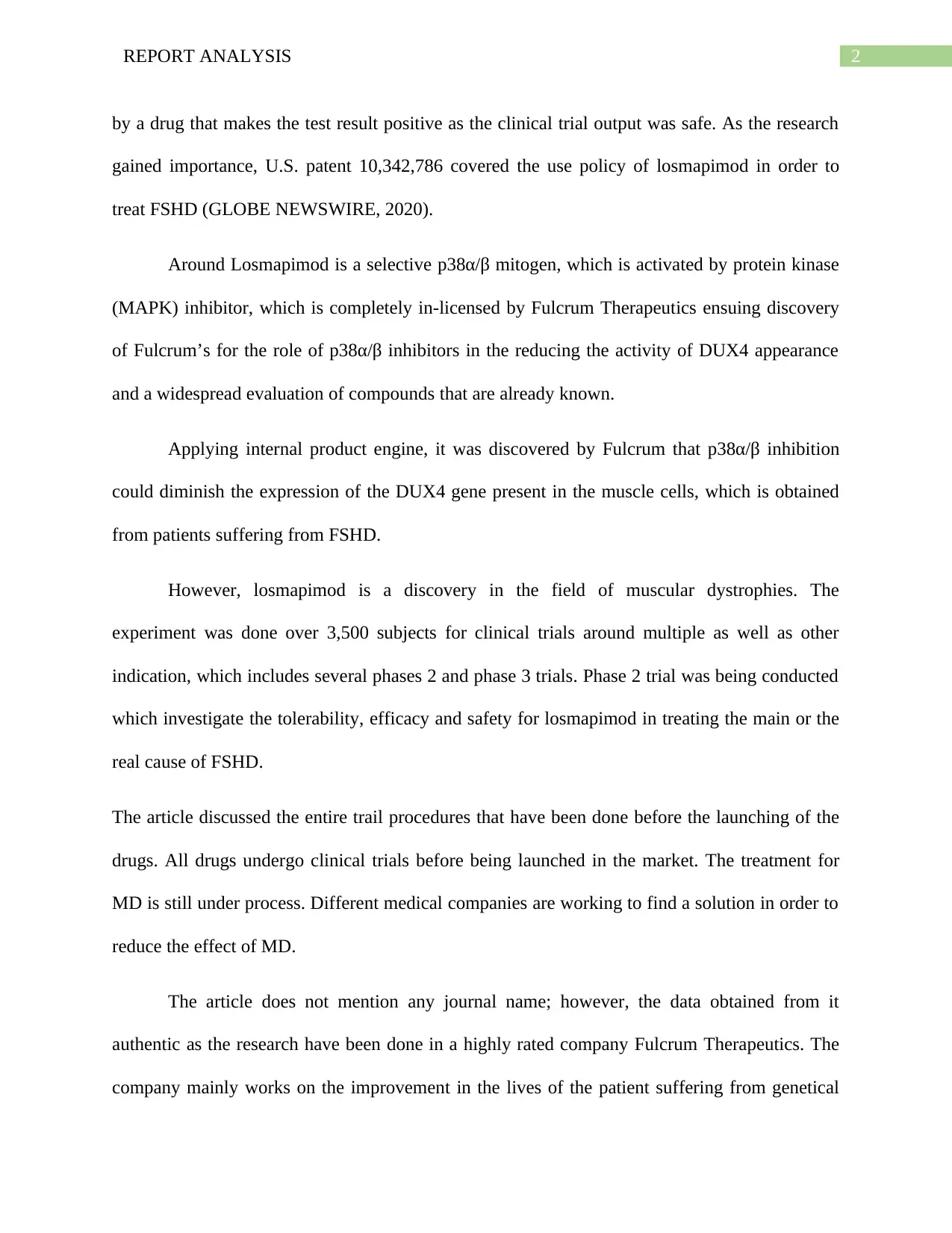
2REPORT ANALYSIS
by a drug that makes the test result positive as the clinical trial output was safe. As the research
gained importance, U.S. patent 10,342,786 covered the use policy of losmapimod in order to
treat FSHD (GLOBE NEWSWIRE, 2020).
Around Losmapimod is a selective p38α/β mitogen, which is activated by protein kinase
(MAPK) inhibitor, which is completely in-licensed by Fulcrum Therapeutics ensuing discovery
of Fulcrum’s for the role of p38α/β inhibitors in the reducing the activity of DUX4 appearance
and a widespread evaluation of compounds that are already known.
Applying internal product engine, it was discovered by Fulcrum that p38α/β inhibition
could diminish the expression of the DUX4 gene present in the muscle cells, which is obtained
from patients suffering from FSHD.
However, losmapimod is a discovery in the field of muscular dystrophies. The
experiment was done over 3,500 subjects for clinical trials around multiple as well as other
indication, which includes several phases 2 and phase 3 trials. Phase 2 trial was being conducted
which investigate the tolerability, efficacy and safety for losmapimod in treating the main or the
real cause of FSHD.
The article discussed the entire trail procedures that have been done before the launching of the
drugs. All drugs undergo clinical trials before being launched in the market. The treatment for
MD is still under process. Different medical companies are working to find a solution in order to
reduce the effect of MD.
The article does not mention any journal name; however, the data obtained from it
authentic as the research have been done in a highly rated company Fulcrum Therapeutics. The
company mainly works on the improvement in the lives of the patient suffering from genetical
by a drug that makes the test result positive as the clinical trial output was safe. As the research
gained importance, U.S. patent 10,342,786 covered the use policy of losmapimod in order to
treat FSHD (GLOBE NEWSWIRE, 2020).
Around Losmapimod is a selective p38α/β mitogen, which is activated by protein kinase
(MAPK) inhibitor, which is completely in-licensed by Fulcrum Therapeutics ensuing discovery
of Fulcrum’s for the role of p38α/β inhibitors in the reducing the activity of DUX4 appearance
and a widespread evaluation of compounds that are already known.
Applying internal product engine, it was discovered by Fulcrum that p38α/β inhibition
could diminish the expression of the DUX4 gene present in the muscle cells, which is obtained
from patients suffering from FSHD.
However, losmapimod is a discovery in the field of muscular dystrophies. The
experiment was done over 3,500 subjects for clinical trials around multiple as well as other
indication, which includes several phases 2 and phase 3 trials. Phase 2 trial was being conducted
which investigate the tolerability, efficacy and safety for losmapimod in treating the main or the
real cause of FSHD.
The article discussed the entire trail procedures that have been done before the launching of the
drugs. All drugs undergo clinical trials before being launched in the market. The treatment for
MD is still under process. Different medical companies are working to find a solution in order to
reduce the effect of MD.
The article does not mention any journal name; however, the data obtained from it
authentic as the research have been done in a highly rated company Fulcrum Therapeutics. The
company mainly works on the improvement in the lives of the patient suffering from genetical
⊘ This is a preview!⊘
Do you want full access?
Subscribe today to unlock all pages.

Trusted by 1+ million students worldwide
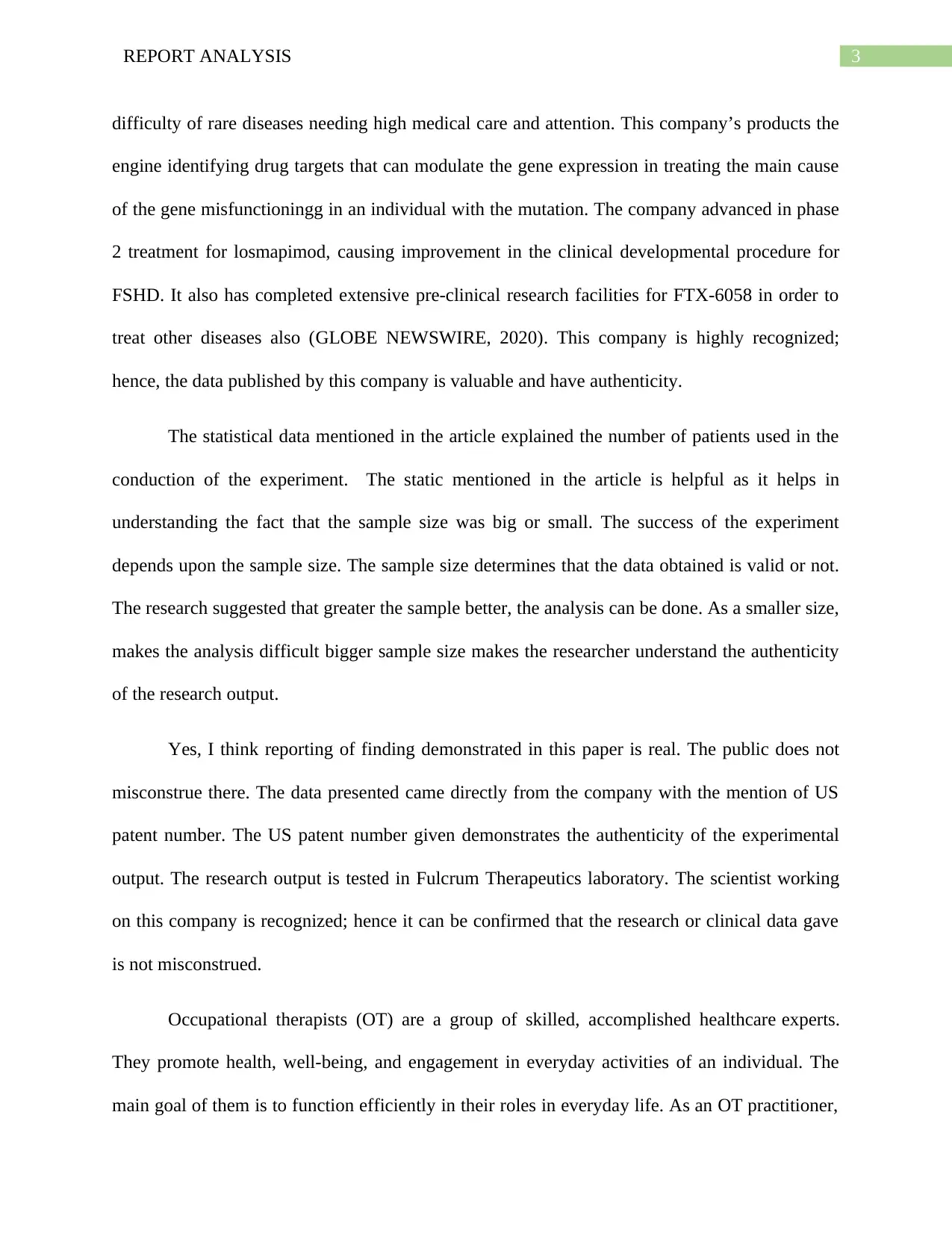
3REPORT ANALYSIS
difficulty of rare diseases needing high medical care and attention. This company’s products the
engine identifying drug targets that can modulate the gene expression in treating the main cause
of the gene misfunctioningg in an individual with the mutation. The company advanced in phase
2 treatment for losmapimod, causing improvement in the clinical developmental procedure for
FSHD. It also has completed extensive pre-clinical research facilities for FTX-6058 in order to
treat other diseases also (GLOBE NEWSWIRE, 2020). This company is highly recognized;
hence, the data published by this company is valuable and have authenticity.
The statistical data mentioned in the article explained the number of patients used in the
conduction of the experiment. The static mentioned in the article is helpful as it helps in
understanding the fact that the sample size was big or small. The success of the experiment
depends upon the sample size. The sample size determines that the data obtained is valid or not.
The research suggested that greater the sample better, the analysis can be done. As a smaller size,
makes the analysis difficult bigger sample size makes the researcher understand the authenticity
of the research output.
Yes, I think reporting of finding demonstrated in this paper is real. The public does not
misconstrue there. The data presented came directly from the company with the mention of US
patent number. The US patent number given demonstrates the authenticity of the experimental
output. The research output is tested in Fulcrum Therapeutics laboratory. The scientist working
on this company is recognized; hence it can be confirmed that the research or clinical data gave
is not misconstrued.
Occupational therapists (OT) are a group of skilled, accomplished healthcare experts.
They promote health, well-being, and engagement in everyday activities of an individual. The
main goal of them is to function efficiently in their roles in everyday life. As an OT practitioner,
difficulty of rare diseases needing high medical care and attention. This company’s products the
engine identifying drug targets that can modulate the gene expression in treating the main cause
of the gene misfunctioningg in an individual with the mutation. The company advanced in phase
2 treatment for losmapimod, causing improvement in the clinical developmental procedure for
FSHD. It also has completed extensive pre-clinical research facilities for FTX-6058 in order to
treat other diseases also (GLOBE NEWSWIRE, 2020). This company is highly recognized;
hence, the data published by this company is valuable and have authenticity.
The statistical data mentioned in the article explained the number of patients used in the
conduction of the experiment. The static mentioned in the article is helpful as it helps in
understanding the fact that the sample size was big or small. The success of the experiment
depends upon the sample size. The sample size determines that the data obtained is valid or not.
The research suggested that greater the sample better, the analysis can be done. As a smaller size,
makes the analysis difficult bigger sample size makes the researcher understand the authenticity
of the research output.
Yes, I think reporting of finding demonstrated in this paper is real. The public does not
misconstrue there. The data presented came directly from the company with the mention of US
patent number. The US patent number given demonstrates the authenticity of the experimental
output. The research output is tested in Fulcrum Therapeutics laboratory. The scientist working
on this company is recognized; hence it can be confirmed that the research or clinical data gave
is not misconstrued.
Occupational therapists (OT) are a group of skilled, accomplished healthcare experts.
They promote health, well-being, and engagement in everyday activities of an individual. The
main goal of them is to function efficiently in their roles in everyday life. As an OT practitioner,
Paraphrase This Document
Need a fresh take? Get an instant paraphrase of this document with our AI Paraphraser
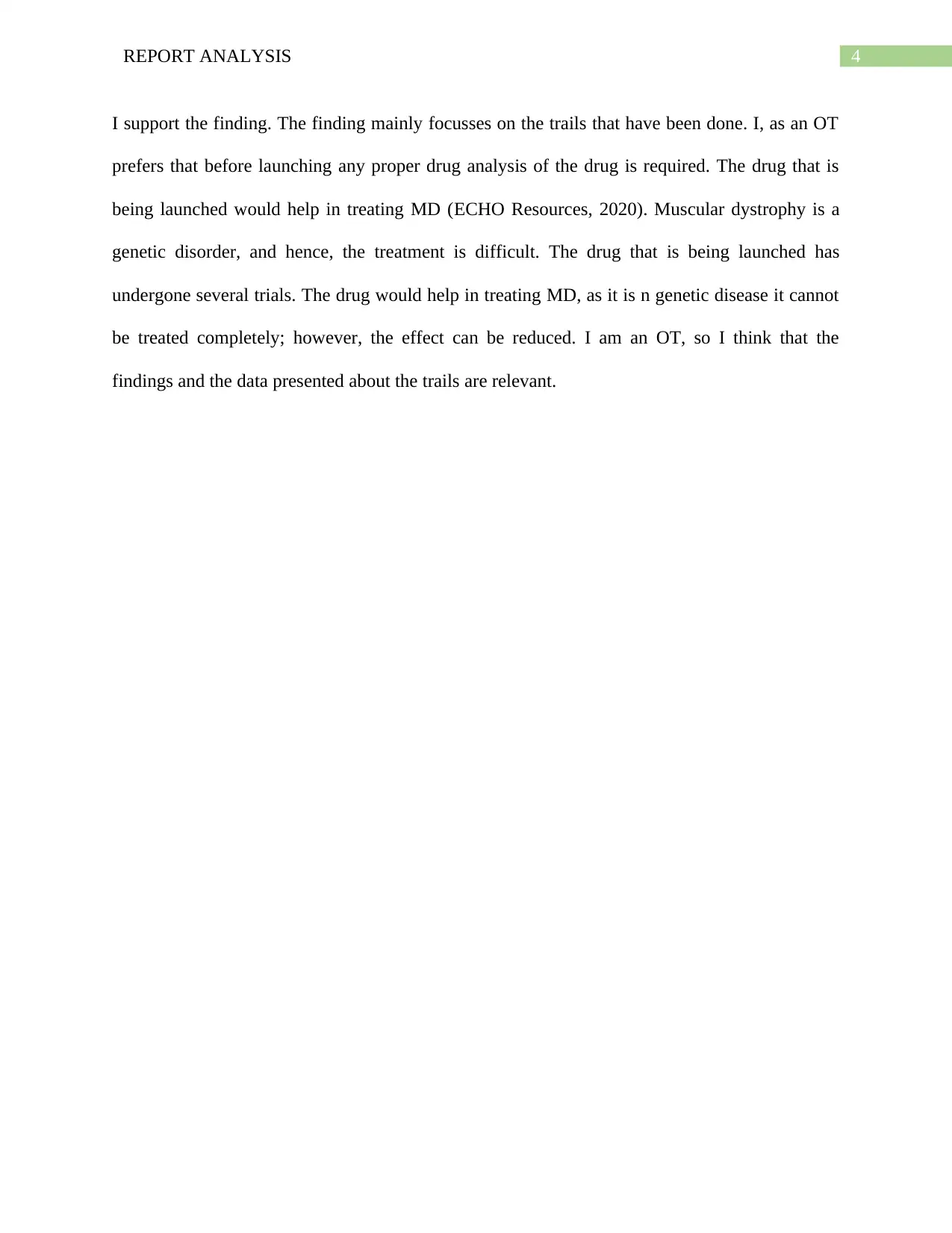
4REPORT ANALYSIS
I support the finding. The finding mainly focusses on the trails that have been done. I, as an OT
prefers that before launching any proper drug analysis of the drug is required. The drug that is
being launched would help in treating MD (ECHO Resources, 2020). Muscular dystrophy is a
genetic disorder, and hence, the treatment is difficult. The drug that is being launched has
undergone several trials. The drug would help in treating MD, as it is n genetic disease it cannot
be treated completely; however, the effect can be reduced. I am an OT, so I think that the
findings and the data presented about the trails are relevant.
I support the finding. The finding mainly focusses on the trails that have been done. I, as an OT
prefers that before launching any proper drug analysis of the drug is required. The drug that is
being launched would help in treating MD (ECHO Resources, 2020). Muscular dystrophy is a
genetic disorder, and hence, the treatment is difficult. The drug that is being launched has
undergone several trials. The drug would help in treating MD, as it is n genetic disease it cannot
be treated completely; however, the effect can be reduced. I am an OT, so I think that the
findings and the data presented about the trails are relevant.
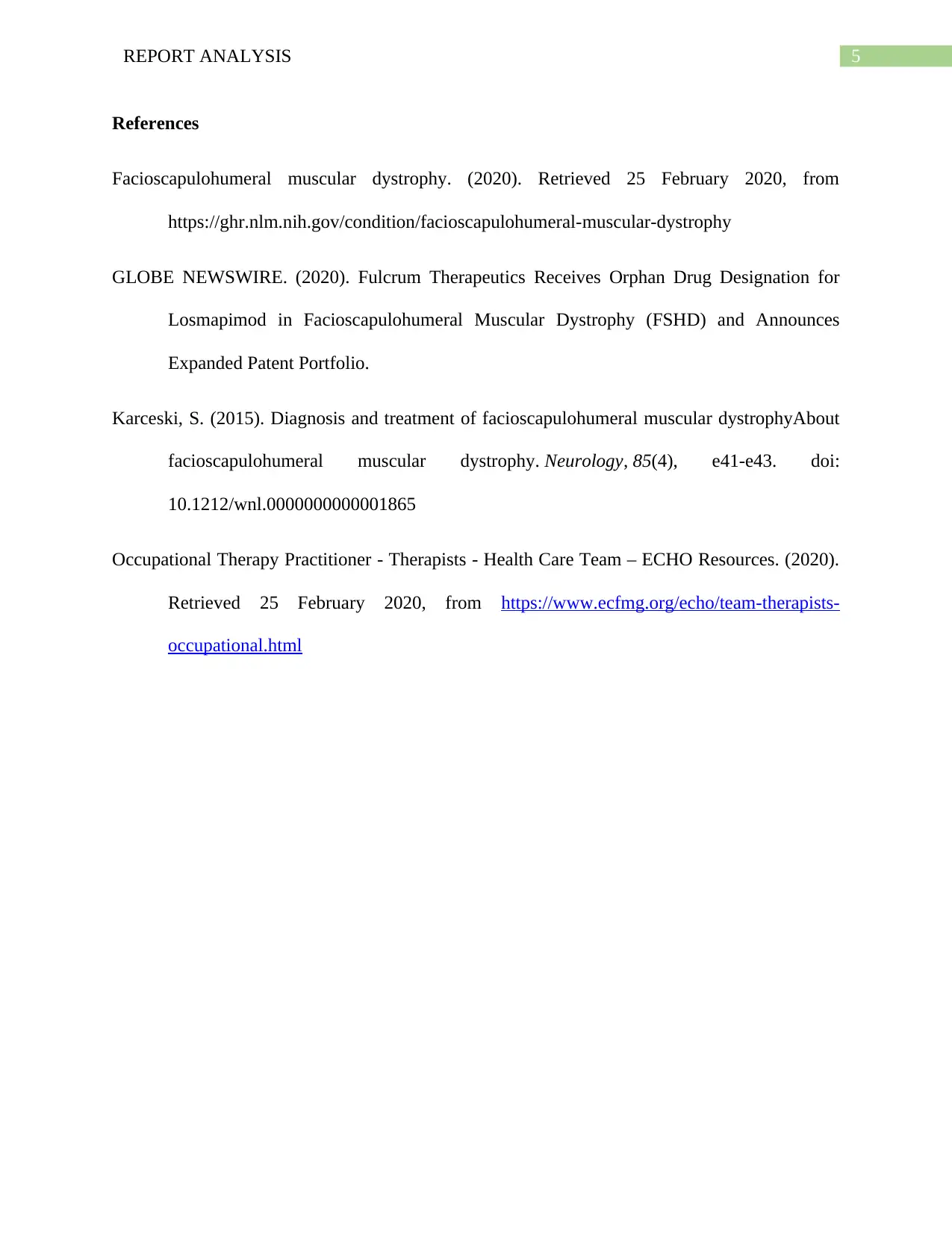
5REPORT ANALYSIS
References
Facioscapulohumeral muscular dystrophy. (2020). Retrieved 25 February 2020, from
https://ghr.nlm.nih.gov/condition/facioscapulohumeral-muscular-dystrophy
GLOBE NEWSWIRE. (2020). Fulcrum Therapeutics Receives Orphan Drug Designation for
Losmapimod in Facioscapulohumeral Muscular Dystrophy (FSHD) and Announces
Expanded Patent Portfolio.
Karceski, S. (2015). Diagnosis and treatment of facioscapulohumeral muscular dystrophyAbout
facioscapulohumeral muscular dystrophy. Neurology, 85(4), e41-e43. doi:
10.1212/wnl.0000000000001865
Occupational Therapy Practitioner - Therapists - Health Care Team – ECHO Resources. (2020).
Retrieved 25 February 2020, from https://www.ecfmg.org/echo/team-therapists-
occupational.html
References
Facioscapulohumeral muscular dystrophy. (2020). Retrieved 25 February 2020, from
https://ghr.nlm.nih.gov/condition/facioscapulohumeral-muscular-dystrophy
GLOBE NEWSWIRE. (2020). Fulcrum Therapeutics Receives Orphan Drug Designation for
Losmapimod in Facioscapulohumeral Muscular Dystrophy (FSHD) and Announces
Expanded Patent Portfolio.
Karceski, S. (2015). Diagnosis and treatment of facioscapulohumeral muscular dystrophyAbout
facioscapulohumeral muscular dystrophy. Neurology, 85(4), e41-e43. doi:
10.1212/wnl.0000000000001865
Occupational Therapy Practitioner - Therapists - Health Care Team – ECHO Resources. (2020).
Retrieved 25 February 2020, from https://www.ecfmg.org/echo/team-therapists-
occupational.html
⊘ This is a preview!⊘
Do you want full access?
Subscribe today to unlock all pages.

Trusted by 1+ million students worldwide
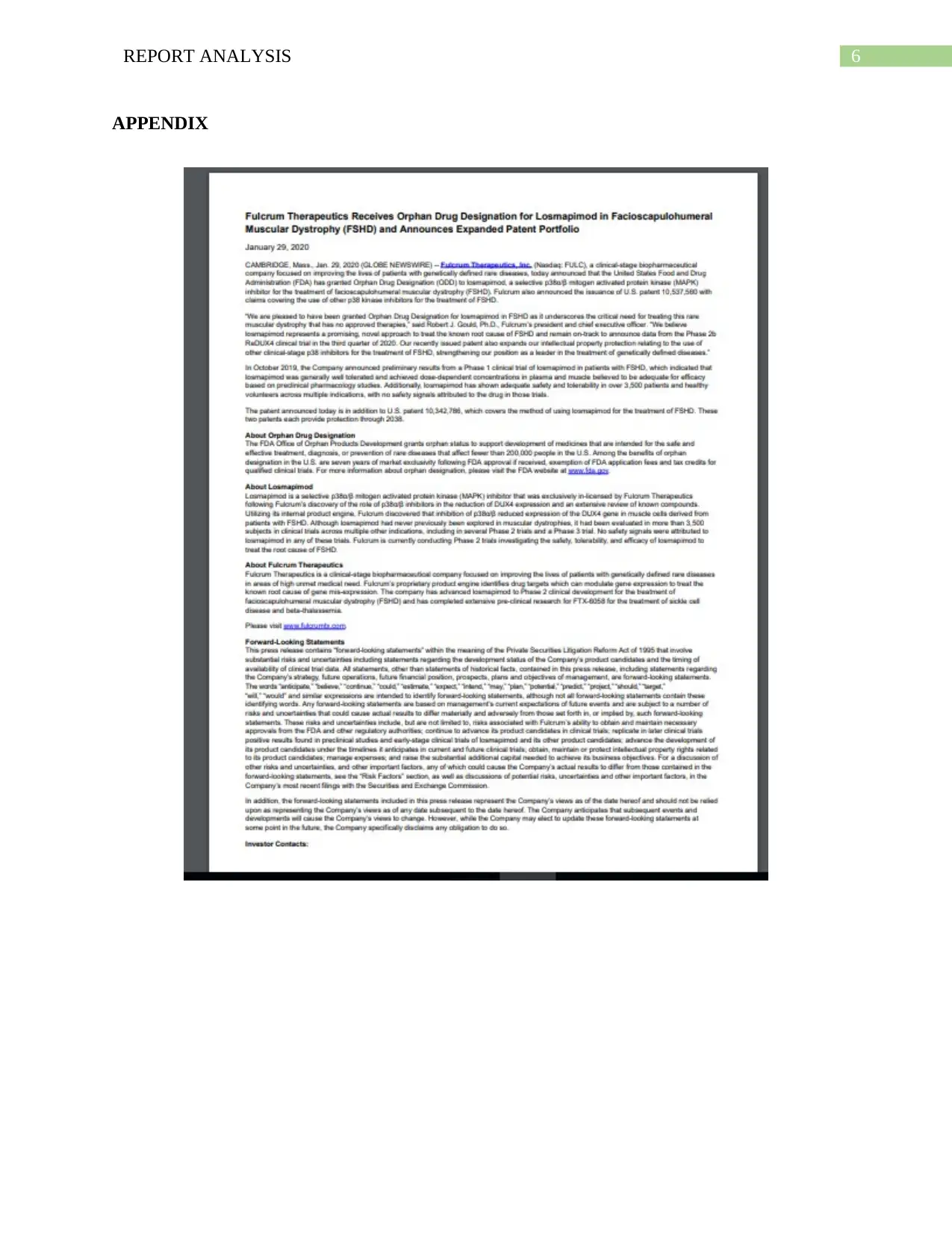
6REPORT ANALYSIS
APPENDIX
APPENDIX
1 out of 7
Your All-in-One AI-Powered Toolkit for Academic Success.
+13062052269
info@desklib.com
Available 24*7 on WhatsApp / Email
![[object Object]](/_next/static/media/star-bottom.7253800d.svg)
Unlock your academic potential
Copyright © 2020–2025 A2Z Services. All Rights Reserved. Developed and managed by ZUCOL.
